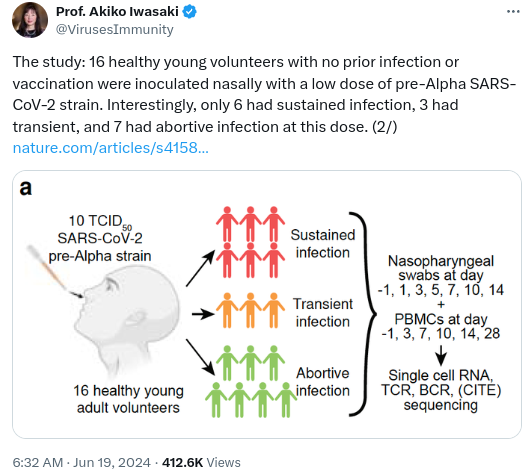Human SARS-CoV-2 challenge uncovers local and systemic response dynamics Rik G. H. Lindeboom,Kaylee B. Worlock,Lisa M. Dratva,Masahiro Yoshida,David Scobie,
Helen R. Wagstaffe,Laura Richardson,Anna Wilbrey-Clark,Josephine L. Barnes,Lorenz Kretschmer,Krzysztof Polanski,Jessica Allen-Hyttinen,Puja Mehta,Dinithi Sumanaweera,Jacqueline M. Boccacino,Waradon Sungnak,Rasa Elmentaite,Ni Huang,Lira Mamanova,Rakesh Kapuge,Liam Bolt,Elena Prigmore,Ben Killingley,Mariya Kalinova,…Sarah A. Teichmann
Nature volume 631, pages189–198 (2024)Cite this article
Abstract
The COVID-19 pandemic is an ongoing global health threat, yet our understanding of the dynamics of early cellular responses to this disease remains limited1. Here in our SARS-CoV-2 human challenge study, we used single-cell multi-omics profiling of nasopharyngeal swabs and blood to temporally resolve abortive, transient and sustained infections in seronegative individuals challenged with pre-Alpha SARS-CoV-2. Our analyses revealed rapid changes in cell-type proportions and dozens of highly dynamic cellular response states in epithelial and immune cells associated with specific time points and infection status. We observed that the interferon response in blood preceded the nasopharyngeal response. Moreover, nasopharyngeal immune infiltration occurred early in samples from individuals with only transient infection and later in samples from individuals with sustained infection. High expression of HLA-DQA2 before inoculation was associated with preventing sustained infection. Ciliated cells showed multiple immune responses and were most permissive for viral replication, whereas nasopharyngeal T cells and macrophages were infected non-productively. We resolved 54 T cell states, including acutely activated T cells that clonally expanded while carrying convergent SARS-CoV-2 motifs. Our new computational pipeline Cell2TCR identifies activated antigen-responding T cells based on a gene expression signature and clusters these into clonotype groups and motifs. Overall, our detailed time series data can serve as a Rosetta stone for epithelial and immune cell responses and reveals early dynamic responses associated with protection against infection.
https://www.nature.com/articles/s41586-024-07575-x
HLA class II histocompatibility antigen, DQ(6) alpha chain is a protein that in humans is encoded by the HLA-DQA2 gene. Also known as HLA-DXA or DAAP-381D23.2, it is part of the human leucocyte antigen system.[5]
The protein encoded by this gene is expressed, but unlike HLA-DQA1, it is apparently unable to heterodimerize with HLA class II beta chain paralogues.[6] The low level of HLA-DQA2 expression is apparently due to impaired transcription factor binding to the HLA-DQA2 gene promoter.[7]
ワクチン接種により抗原原罪が発症したらもともとは新型コロナに感染しない人も…
そう言えばワクチン接種開始以前はほとんど新型コロナに感染する人がいなかった国があったような…
LoLLoLLoLLoLLoLLoLLoL
LoLLoLLoLLoLLoLLoLLoL
LoLLoLLoLLoL









・既存コロナウイルスへの感染および継続的な曝露による交差免疫
返信削除・新型コロナウイルスへ無症状感染/微症状感染して、感染に気が付かなかった
・BCGワクチンの接種
このあたりが重要かな?
生まれたばかりの赤ん坊にとっても何でもなかったという点を考えると、全部ハズレ。
削除Innate immune systemで解決だったというだけでしょ。必死になって否定する人たちが多いけれど、人種間・民族間での遺伝子の違いは大きいんすよ。持って生まれたモノの違いが決定的ということもある。そういう話。
削除要するに、偶像崇拝者の皆様が必死になって真の神を否定しているという事実がパンデミックごっこを通じて可視化されているということなのよね。
削除と後講釈wwwwwweew
削除日本人のファクターXは結構強く、2回ショットしてもまだ欧米に比べてコロナ感染が少なかった感じ。
返信削除3回ショットで免疫崩壊した気がする。
そんな感じでしょうね。
削除永年培ってきた
返信削除自然免疫への
リスペクトww
種としての
祖先への
リスペクトww
https://x.com/mezameworld/status/1808821368273973359
返信削除ワクチン効果
ある免疫学者によると、コロワク未接種かつコロナ感染済みの人は、コロナレプリコンワクチンのシェディング受けても細胞性免疫で排除できるだろうとのこと。
返信削除さすがプロフアキ子イワサキwww
返信削除